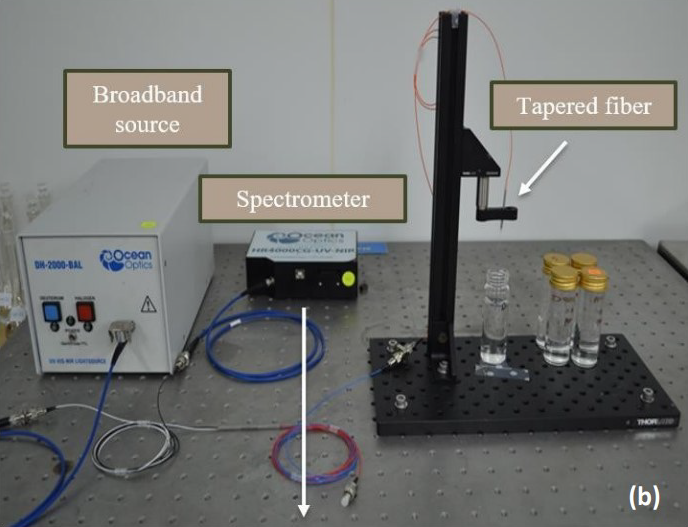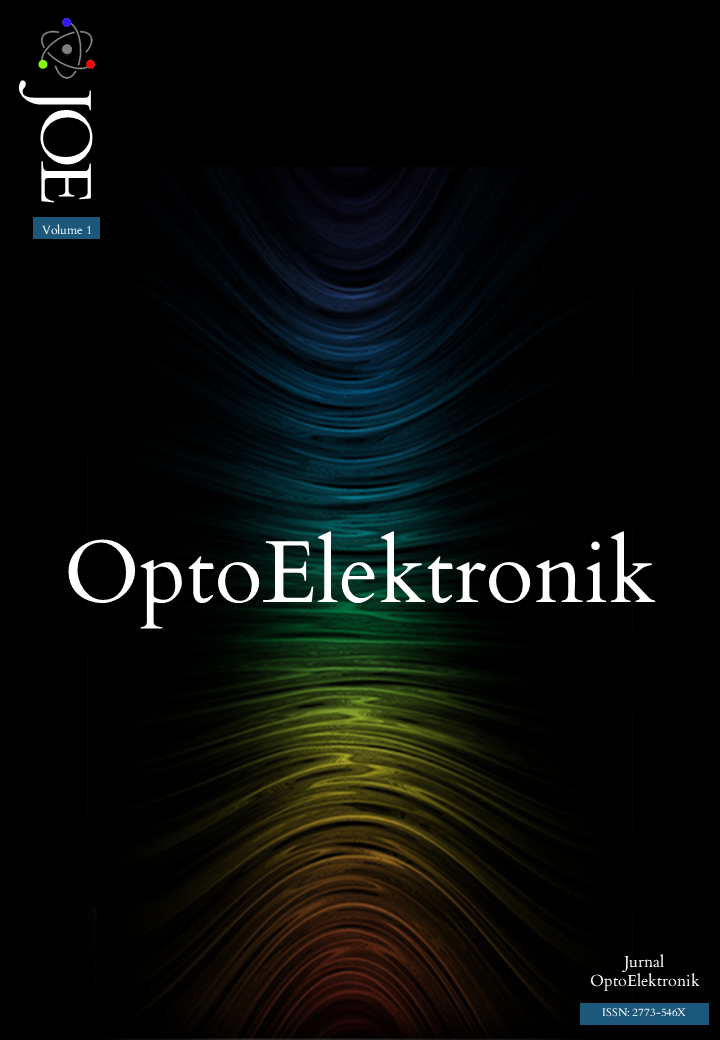Fiber Optic based Localized SPR for Nutrients Detection in Modern Agricultural Applications
DOI:
https://doi.org/10.53655/joe.m7941uKeywords:
Optical fiber, Optical sensors, Nutrients, SoilsAbstract
Detection of nutrients in the hydroponics system, particularly nitrogen, phosphorus, and potassium (NPK) are critical to ensure the good production of crops. Currently, nutrients are analyzed using spectroscopy and electrochemical techniques, which are tedious and sophisticated. This study was conducted to develop a localized surface plasmon resonance (LSPR) fiber optic sensor technique to measure how much content of these nutrients should be added in the soil to increase crop fertility. The main objectives of this study are to study the LSPR fiber sensor technology on NPK in hydroponic systems, to create a fiber optic sensor technique for measuring NPK in hydroponic systems, and finally to characterize the performance of fiber optic sensors for measuring NPK in hydroponic systems. The utilization of the sensing materials, chitosan in this work is to improve the sensitivity feature of the sensor. Chitosan is coated on the surface of the tapered optical fiber prior to the LSPR NPK detection. The results of the absorption spectra will be visible at the end of the experiment where the obtained data are analyzed using SpectraSuite software. The results show that a good linearity was obtained when used AgNP/chitosan as the sensing material with the sensitivity of 0.041 nm ppm-1 in comparison to that of AgNP with the sensitivity of 0.039 nm ppm-1. A better limit of detection (LOD) and limit of quantification (LOQ) was also observed for AgNP/chitosan which are 35.61 ppm and 107.91 ppm, respectively. Meanwhile, AgNP exhibits LOD and LOQ of 106.16 ppm and 494.43 ppm, respectively. It is expected that this work will be a good contributor to the United Nations Sustainable Development Goals (UN SDG), No. 2: Zero Hunger.
References
C. Wang, J. Lv, J.A. Coulter, J. Xie, J. Yu, J. Li, J. Zhang, C. Tang, T. Niu, Y. Gan, Slow-release fertilizer improves the growth, quality, and nutrient utilization of wintering Chinese chives (allium tuberosum rottler ex spreng.), Agronomy. 10 (2020). https://doi.org/10.3390/agronomy10030381.
FAO, World fertilizer trends and outlook to 2018, 2015.
M.Y. Kulkarni, K.K. Warhade, S. Bahekar, Primary Nutrients Determination in the Soil Using UV Spectroscopy, Int. J. Emerg. Eng. Res. Technol. 2 (2014).
J. Peñuelas, B. Poulter, J. Sardans, P. Ciais, M. Van Der Velde, L. Bopp, O. Boucher, Y. Godderis, P. Hinsinger, J. Llusia, E. Nardin, S. Vicca, M. Obersteiner, I.A. Janssens, Human-induced nitrogen-phosphorus imbalances alter natural and managed ecosystems across the globe, Nat. Commun. 4 (2013). https://doi.org/10.1038/ncomms3934.
H.E. Joe, H. Yun, S.H. Jo, M.B.G. Jun, B.K. Min, A review on optical fiber sensors for environmental monitoring, Int. J. Precis. Eng. Manuf. - Green Technol. 5 (2018). https://doi.org/10.1007/s40684-018-0017-6.
S. Idris, N.H. Azeman, N.A. Noor Azmy, C.T. Ratnam, M.A. Mahdi, A.A. Ahmad, Gamma irradiated Py/PVA for GOx immobilization on tapered optical fiber for glucose biosensing, Sensors Actuators, B Chem. (2018). https://doi.org/10.1016/j.snb.2018.07.053.
E. Klantsataya, P. Jia, H. Ebendorff-Heidepriem, T.M. Monro, A. François, Plasmonic fiber optic refractometric sensors: From conventional architectures to recent design trends, Sensors (Switzerland). 17 (2017). https://doi.org/10.3390/s17010012.
N.H. Azeman, N. Arsad, A.A.A. Bakar, Polysaccharides as the sensing material for metal ion detection-based optical sensor applications, Sensors (Switzerland). 20 (2020). https://doi.org/10.3390/s20143924.
N.F. Lokman, N.H. Azeman, F. Suja, N. Arsad, A.A.A. Bakar, Sensitivity enhancement of Pb(II) ion detection in rivers using SPR-based Ag metallic layer coated with chitosan–graphene oxide nanocomposite, Sensors (Switzerland). (2019). https://doi.org/10.3390/s19235159.
D. V Ramane, S.S. Patil, A.D. Shaligram, Detection of NPK nutrients of soil using Fiber Optic Sensor, Int. J. Res. Advent Technol. ACGT. (2015).
S. Guo, S. Albin, Transmission property and evanescent wave absorption of cladded multimode fiber tapers, Opt. Express. 11 (2003). https://doi.org/10.1364/oe.11.000215.
W.B.W.A. Rahman, N.H. Azeman, N.H. Kamaruddin, P.S. Menon, A.A. Shabaneh, M.A. Mahdi, M.H.H. Mokhtar, N. Arsad, A.A.A. Bakar, Label-free detection of dissolved carbon dioxide utilizing multimode tapered optical fiber coated zinc oxide nanorice, IEEE Access. 7 (2019). https://doi.org/10.1109/ACCESS.2018.2888626.
J. Villatoro, D. Monzón-Hernández, D. Luna-Moreno, In-line optical fiber sensors based on cladded multimode tapered fibers, Appl. Opt. 43 (2004). https://doi.org/10.1364/AO.43.005933.
S.H. Girei, A.A. Shabaneh, H. Ngee-Lim, M.N. Hamidon, M.A. Mahdi, M.H. Yaacob, Tapered optical fiber coated with graphene based nanomaterials for measurement of ethanol concentrations in water, Opt. Rev. 22 (2015). https://doi.org/10.1007/s10043-015-0075-8.

Downloads
Published
How to Cite
Issue
Section
License
Copyright (c) 2023 Irfan Mohd Hanafi, Nur Hidayah Azeman, Mohd Hafiz Abu Bakar, Nur Afifah Ahmad Nazri, Rozita Sulaiman, Ahmad Ashrif A Bakar

This work is licensed under a Creative Commons Attribution-NonCommercial 4.0 International License.



